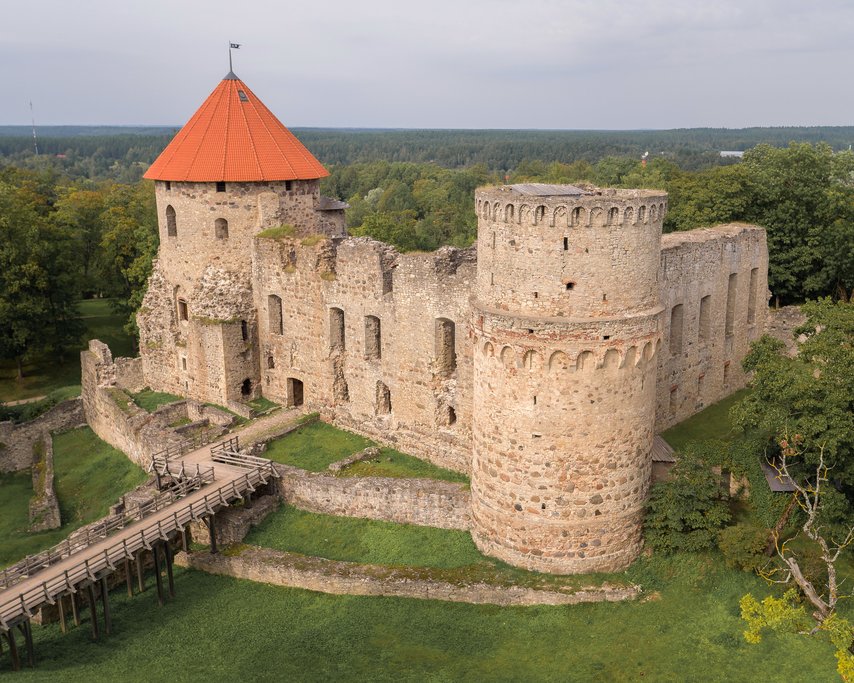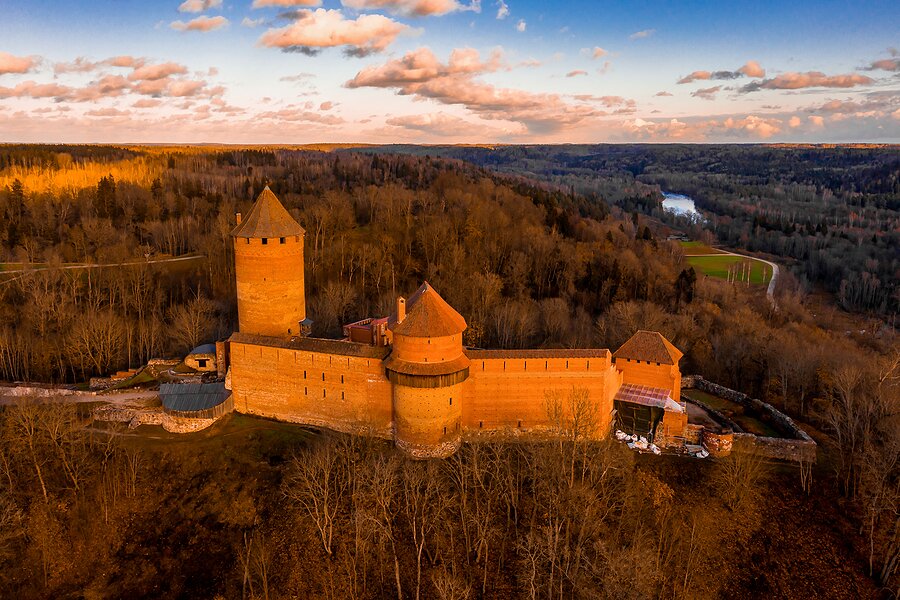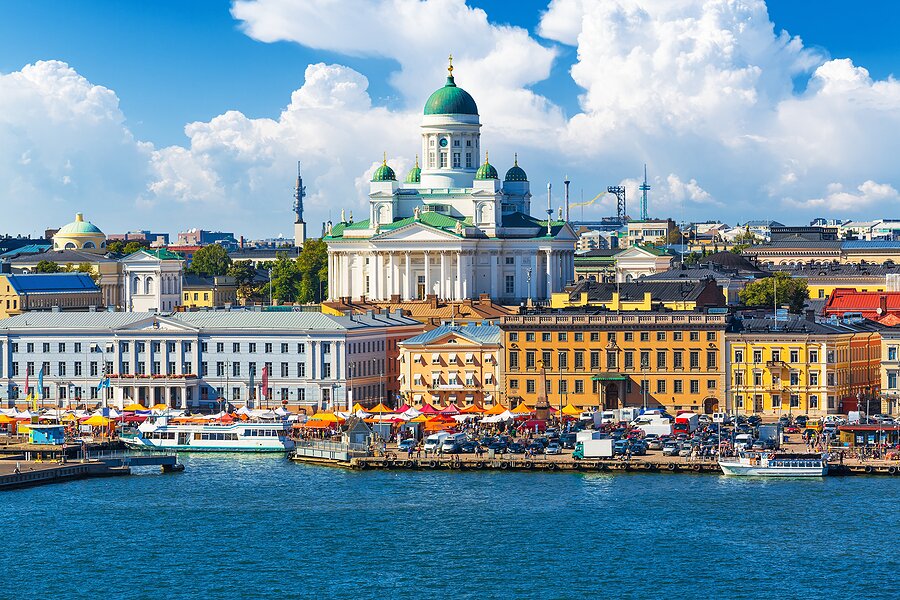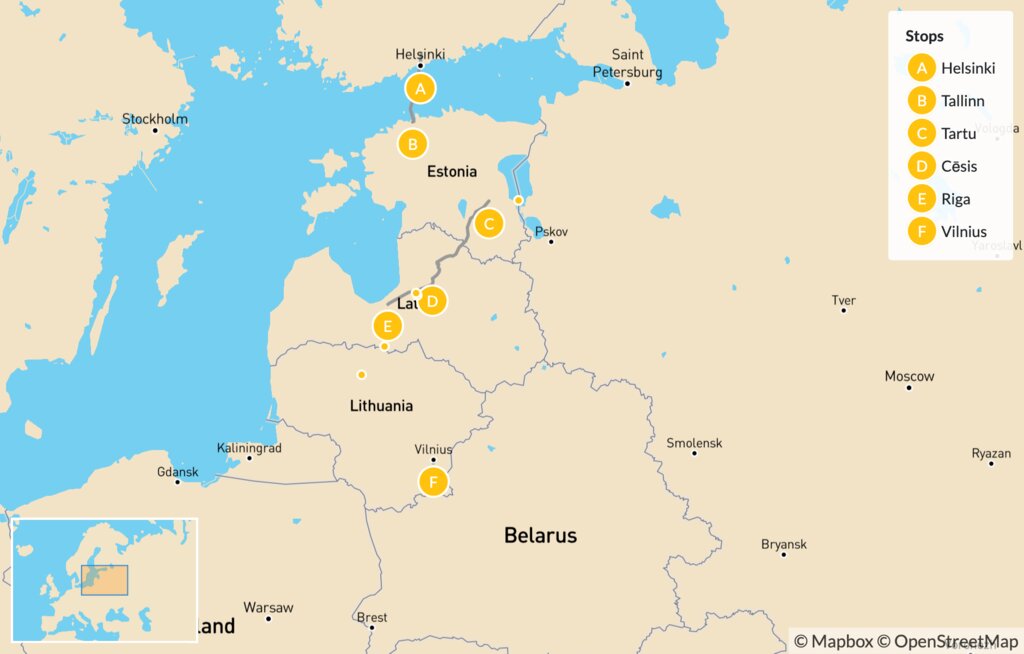Highlights
- Stroll along Helsinki's colorful harborfront & catch a ferry across the Bay of Finland
- Explore the romantic cobbled streets of Tallinn's medieval Old Town
- Sample Latvian delicacies in Europe's largest covered market
- Climb to Lithuania's iconic Hill of Crosses
- Discover the unspoiled forests, lakes & castles of Baltic Europe
Brief Itinerary
| Day | Highlights | Overnight |
|---|---|---|
| Day 1 | Arrive in Helsinki | Helsinki |
| Day 2 | Tour Helsinki's Cultural Landmarks, Visit Porvoo | Helsinki |
| Day 3 | Ferry to Tallinn, Walking Tour of Old Town & the Great Guild | Tallinn |
| Day 4 | Day Trip to Lahemaa National Park | Tallinn |
| Day 5 | Transfer to Tartu via Lake Peipus & Old Believer's Tea Ceremony | Tartu |
| Day 6 | Visit the Estonian National Museum | Tartu |
| Day 7 | Transfer to Cēsis, Tour the Old Town & Castle | Cēsis |
| Day 8 | Transfer to Riga via Sigulda, Turaida & Gauja National Park | Riga |
| Day 9 | Walking Tour of Riga, Meditative Music at the Ethnographic Open-Air Museum | Riga |
| Day 10 | Transfer to Vilnius via Rundāle Palace & the Hill of Crosses | Vilnius |
| Day 11 | Vilnius Walking Tour, Visit Trakai Castle, Traditional Lithuanian Cooking Class | Vilnius |
| Day 12 | Depart Vilnius |
Detailed Itinerary
Day 1: Arrive in Helsinki

Welcome to Helsinki! Upon arrival at the airport, you'll be met by your driver and transferred to your hotel to settle in. Finland's green and lively capital is located at the crossroads of western and eastern culture, and its colorful city center boasts a remarkable array of architectural interests, from Art Nouveau and 1920s classicism to Neo-Renaissance and Byzantine-Russian.
The rest of the afternoon is free for you to rest up or explore the city on your own. For dinner, immerse yourself in Helsinki's modern culinary scene, heading to one of its many cutting-edge gourmet restaurants that put a new spin on traditional Nordic cuisine.
Day 2: Tour Helsinki's Cultural Landmarks, Visit Porvoo

This morning you'll get to the heart of Helsinki with a private sightseeing tour. Visit the city's cultural landmarks and historical monuments, including the Olympic Stadium, the Sibelius Monument (dedicated to Finnish composer Jean Sibelius), Esplanade Park, Uspenski Orthodox Cathedral, and Helsinki Cathedral. Head to Senate Square to discover the oldest part of the city, home to the Government Palace and the University of Helsinki, as well as the green-domed 19th-century Lutheran Cathedral. Continuing to the scenic harborfront, you'll find the bustling stalls of Old Market Hall, Finland's oldest indoor market.
In the afternoon, your driver will take you on an hour's journey out of the city to reach Porvoo. Dating back over 800 years, this charming city is known for the red-ochre houses and cobbled streets of its Old Town. In the perfectly preserved center, you'll find charming cafés, boutiques, and Porvoo Cathedral, an iconic church that dates back to the turn of the 14th century.
Not surprisingly, over the years, members of Finland's arts and literature community have flocked to Porvoo for its obvious charms. You can see the former home (now a museum) of J.L. Runeberg (1804-1877), the national poet of Finland, on a stroll around the city's landmarks. Porvoo is also blessed with an abundance of parks, both within the town and surrounding it, and you'll have the chance to stretch your legs on the many scenic nature trails before transferring back to Helsinki for the evening.
Day 3: Ferry to Tallinn, Walking Tour of Old Town

This morning you'll say your goodbyes to Finland and transfer to Helsinki's port for a two-hour ferry journey across the Gulf of Finland to Tallinn. The Estonian capital is home to one of the region's best-preserved medieval centers, but there's also a modern edge that you can discover in its lively dining and nightlife scenes. Its waterfront promenades and nearby beaches offer great views of the city and coast and are perfect spots for a romantic stroll at any time of year.
Upon arrival, a driver will be waiting to transfer you to your hotel, where you can get settled in before heading back out for an afternoon walking tour of the city's charming Old Town. In the warmer months, this UNESCO World Heritage Site is abuzz with visitors and locals hitting the streets and taking advantage of the many shops, galleries, souvenir markets, outdoor cafés, and restaurants.
Today's sightseeing tour will take you within the Walls of Tallinn (defensive fortifications dating to 1265) and into the heart of Old Town. You'll visit many historical gems, including Toompea Castle, a stately Baroque castle now home to Estonia's parliament; the 13th-century Dome Church (St. Mary's Cathedral); the Russian Revival-style Alexander Nevsky Cathedral; and the Great Guild Hall, which was a guild for merchants in the 14th century and is now the Estonian History Museum.
In the evening, get into the historic spirit of things by heading to Town Hall Square in Old Town to enjoy a traditional Estonian meal at a restaurant in a medieval setting.
Day 4: Day Trip to Lahemaa National Park

After breakfast, a 45-minute drive east takes you to Lahemaa National Park. Located on the country's north coast, Lahemaa sits on 1,877 square miles (725 sq km) and has many hiking trails that will take you through bogs, forests, and up to the largest natural waterfall in Estonia. There's also incredible biodiversity here, and it's home to many species of birds and animals like wolves, red deer, wild boars, and even lynxes. Lahemaa National Park is considered one of the last unspoiled regions of the Baltic coastline.
On today's private walking tour of the park, you'll visit Käsmu Village, which sits on a scenic bog surrounded by lakes and streams. Stop by some historic fisherman's villages, and spend some time at Palmse Manor, an opulent 16th-century estate. Considered one of the country's most impressive examples of Baroque architecture, the grand setting includes expansive grounds featuring a greenhouse, hedgerows, gardens, a park with gazebos, and a bathhouse overlooking a pond.
After spending the day soaking up the beauty of Estonia's unspoiled nature, you'll be transferred back to Tallinn for the evening.
Day 5: Transfer to Tartu via Lake Peipus & Old Believer's Tea Ceremony

After breakfast and check-out, your driver will pick you up for today's drive toward Tartu. Along the way, you'll skirt the shores of Lake Peipus, the fifth-largest lake in Europe, and stop at the lakeside village of Kolkja to discover the area's unique cultural and religious legacy. Home to one of the largest Russian Orthodox Old Believers communities in Europe, these religious refugees are strict adherents to Eastern Christian Orthodoxy as it was practiced before the Russian reforms of the 17th century.
You'll learn more with a visit to the Kolkja Museum of Old Believers, where a traditional tea ceremony awaits. Exhibits feature traditional clothes, household items, handicrafts, tools, photos, and other items associated with the Old Believers. These displays cover a long period of history, as the Old Believers have been practicing their religious traditions for more than 1,000 years.
Chat with a local specialist who can help organize your trip.
Start with a visit to the Supreme Court of Estonia and the Town Hall, which dates to 1782 and is located in the main square. The city's most famous building, however, is the neoclassical University of Tartu, which dates to 1632 and is the national university of Estonia. You'll also visit the remnants of the Tartu Dome Church and enjoy a walk along the riverfront.
Day 6: Visit the Estonian National Museum

Today you'll learn about Estonia's history, folk art, and ethnography with a tour of Tartu's Estonian National Museum. Founded in 1909, the museum centers around the heritage of folklorist Jakob Hurt and preserves the history, life, and traditions of Estonia and its populations, including the Finno-Ugric community and religious minorities. The museum is an important generator and developer of cultural dialogue, linking the past and the future. Enjoy perusing historical relics in religion, fashion, homelife, and economics, as well as holiday celebrations and rural peasant life.
After the tour, you'll have the rest of the afternoon and evening to spend at your leisure in the city of Tartu. If you're interested in visiting more museums, check out the KGB Cells Museum or the Estonian Literary Museum. You can also relax along the riverfront and go for a swim at the public beach.
Day 7: Transfer to Cēsis, Tour the Old Town & Castle

Today you'll bid Estonia farewell and hop over the border to neighboring Latvia. Your destination is the town of Cēsis, a medieval gem and the third-oldest town in the country. During a guided walking tour, you'll experience the 800-year-old history visible in its streets and ancient castle complex. Start with a visit to the charming ruins of its historic castle, learn about the area's rich history, and feel the medieval atmosphere by candlelight. Continue to the evocative Old Town to see highlights such as Roze Square, Princess House, and St. John's Church.
Your afternoon is free to get settled into your hotel, relax, and explore the town at your leisure.
Day 8: Transfer to Riga via Sigulda, Turaida & Gauja National Park

Today's journey toward the Latvian capital takes you through the stunning Gauja National Park, Latvia's largest and oldest national park. Along the way, you'll stop to tour the ruins of Sigulda Castle, built by crusaders in the year 1207, and Turaida Castle, commissioned by the Archbishop of Riga in 1214. Nearby you'll also find the grand Sigulda New Palace, constructed in the 19th century.
In the afternoon, you'll continue to Riga, the largest city in the Baltics and Latvia's capital. Here you'll get settled into your hotel and rest up for another day of sightseeing in the morning.
Day 9: Walking Tour of Riga, Meditative Music at the Ethnographic Open-Air Museum

Explore the many charms of Riga today as you head straight to Old Town for a guided walking tour. Medieval landmarks you'll visit include the 14th-century Riga Castle; the Lutheran Dome Cathedral, which was built in 1211; the 15th-century St. Peter's Church; and the Swedish Gate, a fortification built in 1698 as part of defensive city walls.
Other historical buildings you'll see include Three Brothers, a trio of homes dating to the 15th-17th centuries, and the Large and Small Guild House, a merchant organization built in the 14th century and later redone in the English Gothic style. You'll also visit the Freedom Monument, which is located on the waterfront and memorializes soldiers killed in the Latvian War of Independence (1918-1920). There's also the Latvian National Opera, a unique architectural masterpiece that dates to 1863.
After the opera house, take a tram ride to the Central Market. This UNESCO World Heritage Site opened in 1930 and takes up 778,000 square feet (72,300 meters), which makes it the largest municipal market in Europe. Here you can wander through the former Zeppelin airship hangars and browse for smoked meats, pickled vegetables, sweets, and trinkets. End your tour at one of the market's many sit-down eateries for a relaxed lunch.
In the afternoon, your guide will take you out of the city to the Latvian Ethnographic Open-Air Museum, located in a lovely pine forest next to Juglas Lake. Here a meditative musical experience awaits, with a concert of ancient sounds from the Latvian traditional string instrument known as a kokle. Relax and enjoy the show, then return to Riga for the evening.Day 10: Transfer to Vilnius via Rundāle Palace & the Hill of Crosses

This morning you'll check out of your hotel and meet your driver for the four-hour journey south to the Lithuanian capital of Vilnius.
Before leaving Latvia, you'll stop for a tour of the exquisite Rundāle Palace. This expansive Baroque complex is situated in the plains of southern Latvia and is a little bit of Versaille in the Baltics. It was commissioned by the Duke of Courland in 1736 to be used as his summer residence and was built by Italian architect Francesco Bartolomeo Rastrelli, who also created Russia's ornate Winter Palace. Today it's a museum, and you can stroll through its grand halls and lavish gardens.
Next, you'll cross into Lithuania to visit one of the country's most enduring and iconic sites—the Hill of Crosses. Located just north of the city of Šiauliai, Pilgrims have been leaving crosses on this small rural hill since 1830, when the site was a pivotal landmark in Lithuania's resistance against Russian aggressors. In the intervening years, the arrival of pilgrims has been so regular that today the hill has over 100,000 crosses, crucifixes, and statues of the Virgin Mary.
In the afternoon, you'll continue to your hotel in Vilnius. The Lithuanian capital sits on the Neris River, dates to the 14th century, and in its heyday was a melting pot of cultures. People flocked here from as near as Poland and as far as Eurasia, many coming to attend Vilnius University. Founded in the 16th century, this was one of the premier learning institutions in Europe. Over the next few centuries, Lithuania was conquered by everyone from Napoleon to Hitler, and it fell under Russian rule after World War II until it seceded from the Soviet Union in 1990.
Day 11: Vilnius Walking Tour, Visit Trakai Castle, Traditional Lithuanian Cooking Class

Other stops include Gediminas Tower, a 15th-century defensive castle on the banks of the river; the Church of St. Peter and Paul, a 17th-century Lithuanian Baroque cathedral; the 15th-century St. Anne's Church, another Baroque gem; Vilnius University, which, having been founded in 1579, is the oldest university in the Baltics; and the Gate of Dawn, the city's medieval defensive fortification, which was built around a chapel that remains a major Catholic pilgrimage site in Lithuania.
In the afternoon, you'll transfer 30 minutes west of Vilnius to Trakai, Lithuania's medieval capital. Situated on a peninsula on Lake Galvė, this village, home to about 5,000 people, is as much a scenic national park as it is a town. Here, amid the unspoiled woodlands and lake islands, rises medieval Trakai Castle, the star landmark of the area. You'll visit this handsome fortification, which was built in the latter half of the 14th century out of red brick and stone in the Gothic style. After exploring the castle, stretch your legs with a stroll around the park.
Back in Vilnius, you can spend the evening learning to cook traditional Lithuanian dishes like cepelinas (potato pie filled with meat, cottage cheese, or mushrooms) with a local-led cooking class. After learning some tips in the kitchen, you'll sit down to a hearty dinner to enjoy the fruits of your labor.
Day 12: Depart Vilnius

Your Baltic adventure comes to a close today as you transfer to the airport to catch your departing flight. Safe travels!
More Nordic & Baltic Itineraries
Looking for more inspiration for your trip to Northern Europe? Check out these other Finland, Estonia, Latvia, and Lithuania itineraries, with outdoor adventures, cultural trips, and best-of tours to hit the highlights.


